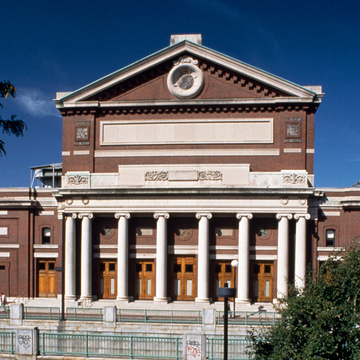Key institutions of Boston culture built new structures on Huntington Avenue at the turn of the century. Henry Lee Higginson, who established the Boston Symphony Orchestra in 1881, commissioned Charles McKim to design a new Symphony Hall (1900, 301 Massachusetts Avenue, NHL/NRD). Working with the acoustical advice of Professor Wallace Clement Sabine of Harvard University, McKim produced a building with excellent sound quality and restrained formality. A central three-story gable-roofed core, fronted by a monumental portico on Massachusetts Avenue, contains the auditorium, flanked by two-story wings for lobbies and offices. A coffered ceiling and copies of ancient statues cast by Pietro Caproni of Boston ornament the auditorium.
One year later and directly across the street, the Massachusetts Horticultural Society (300 Massachusetts Avenue, NR) raised a brick edifice of comparable proportions and increased ornamentation to the designs of Wheelwright and Haven. Founded in 1829 for the purpose of “encouraging and improving the science and practice of horticulture,” the society took an early role in the development of Mount Auburn Cemetery (NC1) in Cambridge and maintained an active program of lectures and exhibitions throughout the nineteenth century. Designed to replace its earlier home on Tremont Street, Horticultural Hall contained large and small exhibition halls and a lecture hall on the ground floor, with a library and offices above, all vaulted using Guastavino tile (WO4). Monumental brick and granite pilasters frame the building, and stone-wreathed circular windows surmount the Massachusetts Avenue entrances.
Other cultural institutions soon joined the neighborhood. In 1902 Wheelwright and Haven designed the Classical Revival, tan brick


